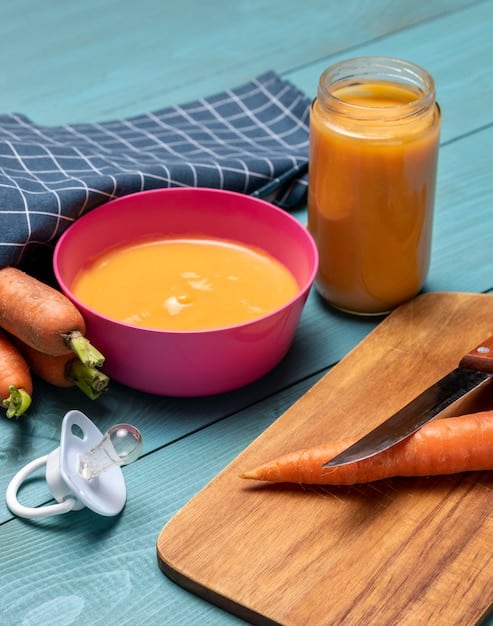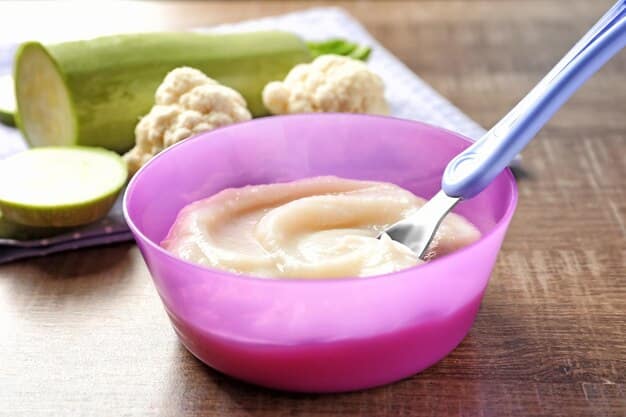Is Your Baby Refusing Solids? 5 Strategies to Encourage Eating

Is your baby refusing solids? Discover five proven strategies to encourage eating, including creating a pleasant mealtime environment, introducing new foods gradually, and making mealtime fun and engaging.
Navigating the world of baby feeding can be challenging, especially when your little one starts refusing solids. It’s a common concern for many parents, but understanding the reasons behind it and implementing the right strategies can make a significant difference. Let’s explore, **Is Your Baby Refusing Solids? 5 Proven Strategies to Encourage Eating**.
Understanding Why Your Baby Might Be Refusing Solids
Before diving into solutions, it’s essential to understand why your baby might be refusing solids. Several factors can contribute to this behavior, and identifying the root cause can help you tailor your approach.
Developmental Readiness
Babies develop at their own pace, and not all are ready for solids at exactly six months. Some may need a bit more time to develop the necessary motor skills and coordination.
Taste Preferences
Just like adults, babies have their own taste preferences. They might not enjoy the flavor or texture of certain foods, which can lead to refusal.
- Ensure Baby Is Ready: Look for signs like sitting up with support, good head control, and showing interest in food.
- Rule Out Medical Issues: Consult with your pediatrician to ensure there are no underlying medical conditions, such as allergies or reflux, causing the refusal.
- Observe Feeding Cues: Pay attention to your baby’s signals – are they truly hungry, or are they trying to communicate something else?
Understanding the reasons behind your baby’s refusal is the first step in addressing the issue effectively. Patience and observation are key.

Strategy 1: Creating a Pleasant Mealtime Environment
The environment in which your baby eats can significantly impact their willingness to try new foods. A relaxed and positive atmosphere can make mealtime more enjoyable.
Minimize Distractions
Turn off the TV, put away toys, and find a quiet space where your baby can focus on eating.
Positive Reinforcement
Offer gentle encouragement and praise when your baby shows interest in food, even if they only take a small bite.
Creating a pleasant mealtime atmosphere not only improves your baby’s eating habits but it also fosters a positive association with food from an early age.
Strategy 2: Introducing New Foods Gradually
Introducing solids should be a gradual process. Overwhelming your baby with too many new foods at once can lead to rejection.
Start Simple
Begin with single-ingredient purees like sweet potato, avocado, or banana. These are mild-flavored and easy to digest.
The Four-Day Wait Rule
Introduce one new food every four days to monitor for any allergic reactions or sensitivities.
- Choose the Right Time: Introduce new foods when your baby is in a good mood and not overly tired or hungry.
- Small Portions: Start with a small amount of the new food and gradually increase the quantity as your baby accepts it.
- Mix Familiar with New: If your baby is hesitant, try mixing the new food with something they already enjoy.
Patience is crucial when introducing new foods. It may take multiple attempts before your baby accepts a new flavor or texture.

Strategy 3: Making Mealtime Fun and Engaging
Turning mealtime into a fun and engaging activity can pique your baby’s interest and encourage them to eat.
Playful Presentation
Arrange food in fun shapes or patterns on the plate to make it visually appealing.
Engage the Senses
Let your baby explore the food with their hands, smell it, and play with it. This can help them become more comfortable with new textures and flavors.
Making mealtime interactive helps your baby develop a positive relationship with food, associating it with enjoyment and discovery.
Strategy 4: Offering Variety and Texture
As your baby gets more accustomed to solids, introducing a variety of tastes and textures can help expand their palate.
Explore Different Flavors
Offer a range of fruits, vegetables, and proteins to expose your baby to different tastes. Consider natural flavors, some herbs and spices, or lemon and lime.
Progress to Different Textures
Gradually move from smooth purees to thicker mashes, and eventually to soft, finger foods as your baby develops their chewing skills.
- Homemade vs. Store-Bought: Both have their pros and cons. Homemade allows for control over ingredients, while store-bought is convenient.
- Be Mindful of Allergens: Introduce common allergens like peanuts, eggs, and dairy one at a time, following your pediatrician’s guidance.
- Safe Finger Foods: Offer soft, easy-to-chew finger foods like cooked carrots, soft fruits, or well-cooked pasta.
Introducing variety and texture early on can help prevent picky eating habits later in life and ensure your baby receives a well-rounded diet.
Strategy 5: Being Patient and Persistent
Perhaps the most important strategy is to remain patient and persistent. It’s normal for babies to refuse foods at times, and it doesn’t necessarily mean they will never eat them.
Don’t Force It
Never force your baby to eat. This can create negative associations with food and lead to mealtime battles.
Offer, Don’t Demand
Continue to offer the rejected food at future meals. It can take multiple exposures for a baby to accept a new food.
Remember, every baby is different, and what works for one may not work for another. Trust your instincts, observe your baby’s cues, and celebrate small victories along the way.
| Key Point | Brief Description |
|---|---|
| 😊 Pleasant Mealtime | Create a calm and distraction-free environment. |
| 🥕 Gradual Introduction | Introduce new foods one at a time to monitor for allergies. |
| 🎉 Make it Fun | Use playful presentation and engage your baby’s senses. |
| 🫄 Be Patient | Continue offering foods and trust the process. |
Frequently Asked Questions (FAQ)
▼
Most pediatricians recommend starting solids around 6 months of age, but always consult with your doctor to ensure your baby is ready.
▼
Signs include good head control, the ability to sit up with support, showing interest in food, and losing the tongue-thrust reflex.
▼
Introduce new foods one at a time and watch for symptoms like rash, hives, vomiting, or diarrhea, consulting a doctor if these appear.
▼
Start with small portions, such as 1-2 tablespoons per feeding, and gradually increase as your baby gets used to eating solids.
▼
Don’t force it. Try again later or mix it with foods they like. It can take 10-15 tries for a baby to accept a new food.
Conclusion
Dealing with a baby who is refusing solids can be stressful, but by understanding the reasons behind it and trying these proven strategies, you can help your little one develop healthy eating habits and enjoy their culinary journey.





